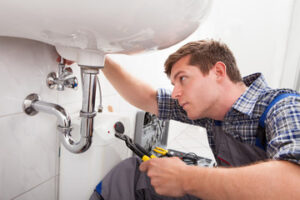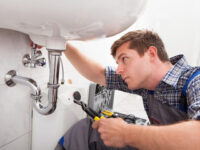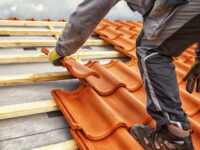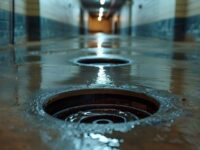How to Recognize the Telltale Signs of Plumbing Trouble
Plumbing is an essential part of your home’s structure that delivers fresh water and safely removes wastewater. It’s important to know how to recognize the telltale signs of broken pipes.

The simplest way to prevent pipe bursts is to keep the home well-insulated. You can also open cabinets that have exposed pipes to allow warmer air to circulate near them. Contact Plumbing Express, Inc. for professional help.
Roots are attracted to the moisture and nutrients in sewer lines, causing blockages that can lead to slow draining sinks, tubs, and toilets. They can also cause sewage backups, which create a health hazard and unpleasant odors. If left unchecked, root intrusion can lead to expensive pipe repairs and replacements. Fortunately, there are steps you can take to prevent this problem.
The first sign of trouble is gurgling noises from your toilets or other plumbing fixtures. These sounds are caused by trapped air in partially blocked pipes. Slow draining is another common symptom of tree roots infiltrating your sewer line. Inspecting your plumbing with a camera can help to determine the location and extent of the problem, allowing your plumber to recommend the most effective solution.
A professional plumber will typically use hydro jetting or a mechanical cutting tool to remove invading roots from your sewer line. These methods don’t damage the pipes, and they can be much quicker and more cost-effective than traditional excavation. If the problem is severe, removing the affected trees or even the entire tree may be necessary.
It’s important to consult with a qualified arborist before planting new trees or adding landscaping. Choosing species with less aggressive root systems and keeping them a safe distance from your sewer lines will minimize the risk of problems in the future. Regular inspections of your sewer line and prompt action when problems arise can also protect the integrity of your pipes and prevent costly damage.
While DIY root-killing solutions such as rock salt and chemical herbicides may temporarily kill invading roots, they will not prevent them from regrowing and damaging your sewer pipes. These DIY methods are not only ineffective, but they can also harm your pipes and the environment.
A plumber with specialized tools and knowledge of pipe maintenance can install a physical or chemical barrier that will stop invading roots from entering your sewer lines. If you have a chronic problem with tree roots, a drain cleaning service can identify the source of the intrusion and recommend the most effective solution.
Leaking Pipes
Leaking pipes are one of the most common problems associated with aging plumbing systems. They can also occur due to damage caused by frost or ground movement. Regardless of the cause, leaking pipes need to be repaired as soon as possible to avoid extensive water damage and expensive repairs.
Several signs of a leaky pipe include musty smells, mould or mildew growth, water stains on walls and ceilings, puddles and wet spots on the floor, and sagging drywall. The constant presence of moisture in the area promotes the growth of bacteria, which can be a health hazard.
Another sign of a leaking pipe is an unexplained increase in your water bill. This can indicate that the pipes are corroding and breaking down, or that a pipe has burst.
Over time, the metal pipes in your home can rust or break down, resulting in a leak. In addition to causing significant damage, a leaking pipe can lead to an increase in your water bills and damage your foundation and structure.
If you notice that a pipe is leaking, turn off the water supply to minimize damage and call a plumber as soon as possible. In the meantime, you can try to contain the leak by placing a bucket or container under the affected area.
You can also use plumber’s tape or putty to patch a leaky pipe. Make sure the area is dry before applying these materials, and always wear gloves when handling them.
In some cases, you may be able to repair a small leak yourself, such as with a rubber patch and adjustable pipe clamps. However, it is important to contact a professional plumber for a full inspection and repair. An expert can check the entire system for any other problems that could require replacement, and provide guidance on how to avoid future issues.
Diverting Water
Diversion structures direct surface runoff away from a river or stream bed to prevent erosion and sedimentation. They include dams, weirs, field drains, culverts, canals and pipes. They can also be used to reduce flood risks. They can have a positive effect on river biodiversity and may improve water quality by diverting nutrient-rich water into land that needs it.
They can be constructed to increase soil fertility and reduce the amount of phosphorous, nitrogen and potassium that leaves a watershed. They can also help restore natural flow patterns and reduce flooding and gully formation. However, they can have negative effects on mahinga kai if they cause permanent changes to a waterway’s natural characteristics. For this reason, any diversion structure that significantly alters a waterway’s natural character requires a resource consent.
The main problems with sewer diversions are the potential impact on ecosystems and the amount of sewage that is displaced from the system. The potential impacts on ecosystems include a reduction in the contribution of coarse detritus and autochthonous resources to fish diets and a decrease in dissolved oxygen levels in the water column. The amount of sewage that is displaced by the system can also affect wildlife and plants in downstream areas.
If sewage backups occur in your home, it’s essential that you contact emergency plumbing services right away. This will ensure that your family doesn’t suffer from exposure to sewage waste and that the sewage is cleared as quickly as possible. It’s also important to avoid using any water in your home until a plumber has completed the necessary repairs. This includes flushing toilets, washing clothes, showering and using sinks.
A professional plumber will use video equipment to locate the clog or damage and determine what’s causing it. They will then employ a range of techniques to clear the line, depending on its condition. For example, they might use hydro jetting to clear materials that have accumulated on the interior of the pipe walls. They might also use an auger to break up and remove clogs.
Using a Barrier System
Performing routine maintenance and staying alert for early signs of trouble are the best ways to avoid costly sewer line issues. But, if you do encounter any problems that seem out of the ordinary, such as frequent drain clogs or unusual indentations in your yard, it is crucial to consult with a professional plumber to assess the situation and make necessary repairs.
Installing a physical root barrier is a proactive measure that prevents invasive roots from damaging the integrity of your sewer pipes. Typically, these barriers are made of plastic or metal and they encircle sewer pipes, creating a protective shield that deters roots from penetrating the pipe. They are an effective alternative to removing problematic roots or chemically treating the soil, and they can be custom-designed for specific plumbing situations.
Using a backflow prevention device is another simple way to keep wastewater flowing in the right direction and avoid clogs. These devices are installed in your home’s toilets, showers, and sinks to ensure that sewage is not flowing back into the house. They are available in a range of sizes to suit different plumbing configurations, and can be installed on new construction or during sewer pipe replacement projects.
Another common way to prevent clogged pipes is to avoid flushing non-dissolvable items like feminine hygiene products, paper towels, and solid waste. Instead, dispose of these items in the trash or a recycle bin to minimize their impact on your plumbing.
Passive barriers also provide a layer of protection against contaminated vapor intrusion (VI). This type of mitigation system is designed to prevent VI from entering and accumulating beneath the structure, as well as to manage nuisance water. These barriers are typically used in conjunction with a passive venting system, and they are often referred to as passive VI mitigation systems (VIMS). The effectiveness of a VIMS is determined by the quality of the barrier material, its construction process, and its ability to reduce chemical diffusion from contaminated soils through the barrier.






